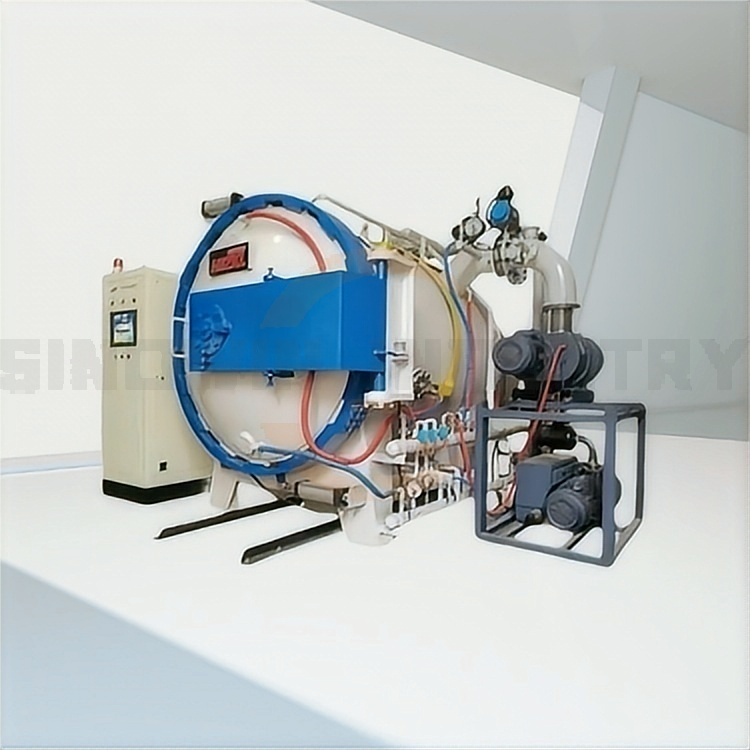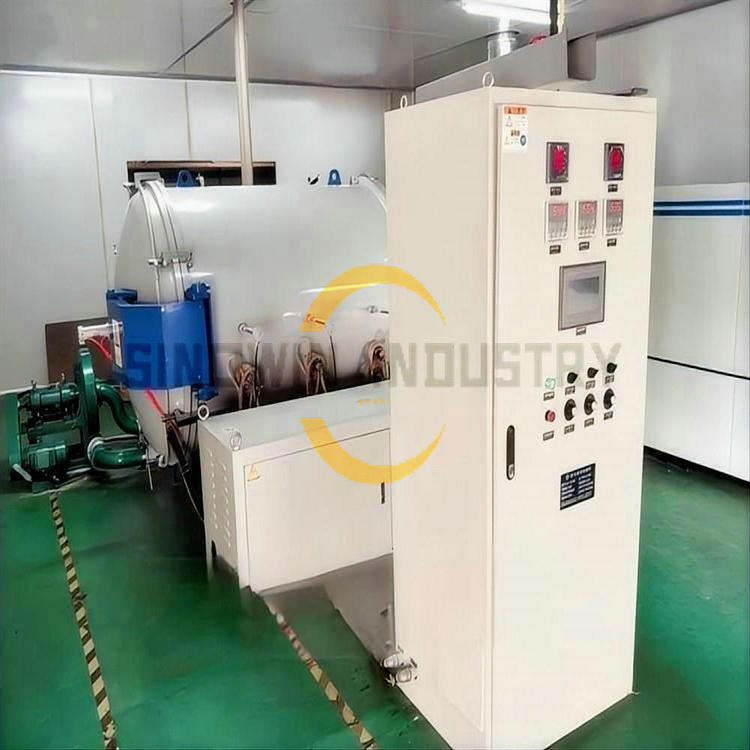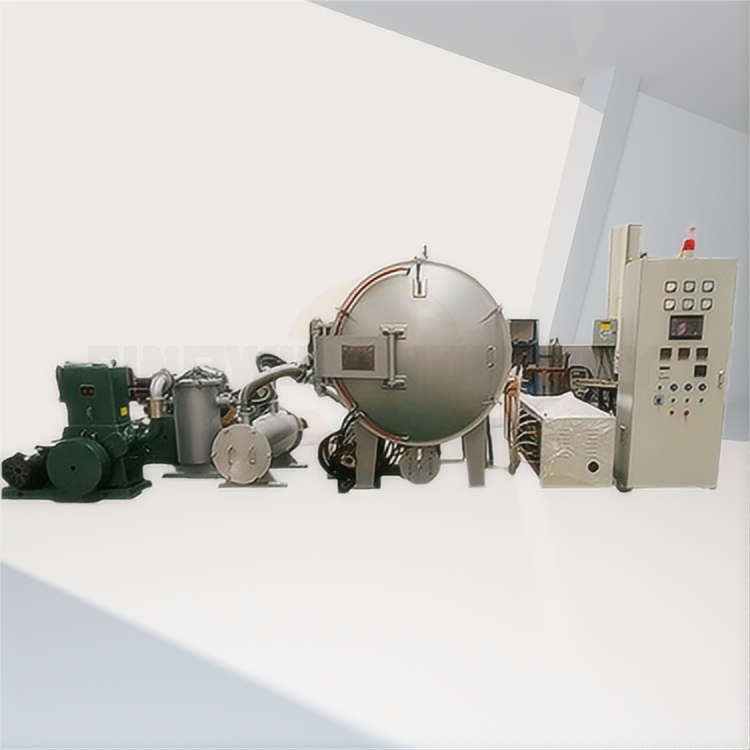Product Description:
The Induction Vacuum Sintering Furnace stands out for its capabilities in both vacuum and atmosphere sintering processes. Depending on the specific sintering time requirements, a single power supply can be configured to control multiple furnaces, allowing for individual temperature management, including heating and cooling, thus facilitating continuous operation. this vacuum furnace designe and produced by nanyang sinowin industry offers an exceptional solution for advanced sintering applications.,it is specifically designed to handle a variety of high-performance materials including silicon carbide, ceramics, hard alloys, powder metallurgy, tungsten, molybdenum, aluminum-nickel-cobalt permanent magnets, SmCo5, Sm2Co17, and titanium alloys.
Key Technical Specifications:
- Maximum Operating Temperature: 2450℃
- Usual Operating Temperature: 2400℃
- High-Temperature Zone Dimensions: 200-2000mm x 300-4000mm or square configurations
- Heating Method: Induction heating
- Working Atmosphere: Nitrogen and Argon gases
- Temperature Uniformity: ≤±10℃
- Temperature Control: PID intelligent program control and manual control options
- Temperature Control Precision: ±1℃
- Multi-Furnace Power Supply Configuration: Supports separate heating and cooling cycles for enhanced efficiency
- Temperature Measurement: Utilizes WRe5/26 thermocouples (0-1700℃) combined with American RATEK dual-color infrared thermometers (1000-3200℃) and single-color infrared thermometers (300-1100℃)
- User-Friendly Operation: Features multi-channel data acquisition with user-friendly interface, providing clear visibility of operating parameters and reduced labor intensity
- Data Recording and Storage: Supports data logging with historical curve viewing and transfer to portable storage devices
Parameter of our 2400 degree Induction Vacuum Sintering Furnace:
| Induction Vacuum Sintering Furnace Specification | ||||
| Working temperature(℃) | 2400 | 2400 | 2400 | 2400 |
| Ultimate temperature(℃) | 2450 | 2450 | 2450 | 2450 |
| Working size(mm) | 400X400X1200 | 500X500X1400 | 550X550X1600 | 800X800X3000 |
| Power(KW) | 150 | 250 | 350 | 800 |
| Heating Method | IGBT | |||
| Atmosphere | High Vacuum/Vacuum (optional )N²、Ar etc. | |||
| Ultimate Vacuum (pa) | 6.6X10ˉ3 | |||
Whether you’re in the manufacturing sector or a research facility, our Induction Sintering Furnace is an indispensable furnace and one guaranteed option for your heating treatment industry that combines cutting-edge technology with user-friendly operation.
Donot hesitate to Contact us at once for any further information of Sinowin Industry’s industrial&lab furnaces , and we are not only a supplier but a reliable partner to assist you the safe solutions of the heat treatment .
Product Q&As for our Induction Vacuum Sintering Furnace:
- Q1: What is an Induction Sintering Furnace and how is it used in manufacturing?
- A1: An Induction Sintering Furnace is a specialized device that uses electromagnetic induction to generate heat in conductive materials for the purpose of sintering—essentially fusing powder particles together by heating them without liquefying. In manufacturing, it is widely used for creating high-density metal parts, ceramics, and composites. It provides precise temperature control and rapid heating cycles, making it a preferred choice for advanced material fabrication.
- Q2: What are the advantages of using an Induction Sintering Furnace compared to traditional methods?
- A2: The Induction Sintering Furnace offers several advantages over traditional sintering methods, including faster heating times, reduced energy consumption, and improved process uniformity. The induction method allows for targeted heating, which minimizes thermal shock and deformation, ensuring high-quality outcomes. Additionally, it reduces oxidation risk by creating an inert atmosphere, leading to superior mechanical properties in the finished products.
- Q3: How does the induction sintering process improve the quality of metal parts?
- A3: The induction sintering process enhances the quality of metal parts by providing uniform heating and precise temperature control. This results in better particle bonding, reduced porosity, and improved density in the final component. The rapid heating and cooling cycles also minimize grain growth, enhancing the mechanical and physical properties of the metal parts, making them stronger and longer-lasting.
- Q4: What materials can be processed using an Induction Sintering Furnace?
- A4: An Induction Sintering Furnace is versatile and can process a range of materials, including various metals (such as iron, copper, nickel, and alloys), ceramics, and composite materials. This flexibility makes it suitable for industries including aerospace, automotive, and electronics, where high-performance components are essential.
- Q5: What is the cost of an Induction Sintering Furnace?
- A5: The cost of an Induction Sintering Furnace can vary significantly based on its size, capabilities, and features. On average, a quality furnace can range from $20,000 to over $100,000. For a precise quote that matches your specific needs, we recommend contacting our sales team to discuss your requirements and budget.
- Q6: What factors should I consider when choosing an Induction Sintering Furnace?
- A6: When selecting an Induction Sintering Furnace, consider factors such as the furnace’s heating capacity, process temperature range, material compatibility, control systems (PLC or manual), and warranty offered. Additionally, evaluate the manufacturer’s reputation for service, support, and ease of maintenance to ensure you make a well-informed investment.
- Q7: How can I maintain my Induction Sintering Furnace for optimal performance?
- A7: To maintain your Induction Sintering Furnace for optimal performance, regularly check and clean the induction coils and cooling system to prevent overheating. Ensure the electrical components are free of dust and corrosion. Perform routine inspections as per the manufacturer’s guidelines and address any malfunctioning parts immediately. Keeping a maintenance log can also be beneficial for tracking performance over time. Regular servicing by professionals will ensure longevity and reliability in operation.
Please feel free to send email to us if you have more questions or need further information about our Induction Sintering Furnace!
Parameter of our 2400 degree Induction Vacuum Sintering Furnace:
| Induction Vacuum Sintering Furnace Specification | ||||
| Working temperature(℃) | 2400 | 2400 | 2400 | 2400 |
| Ultimate temperature(℃) | 2450 | 2450 | 2450 | 2450 |
| Working size(mm) | 400X400X1200 | 500X500X1400 | 550X550X1600 | 800X800X3000 |
| Power(KW) | 150 | 250 | 350 | 800 |
| Heating Method | IGBT | |||
| Atmosphere | High Vacuum/Vacuum (optional )N²、Ar etc. | |||
| Ultimate Vacuum (pa) | 6.6X10ˉ3 | |||







